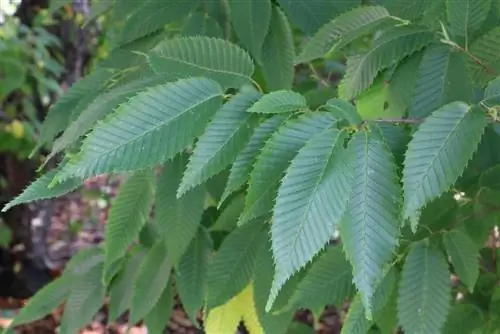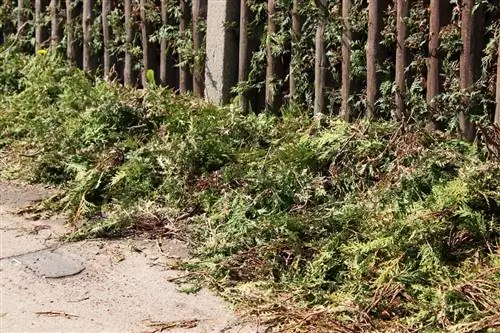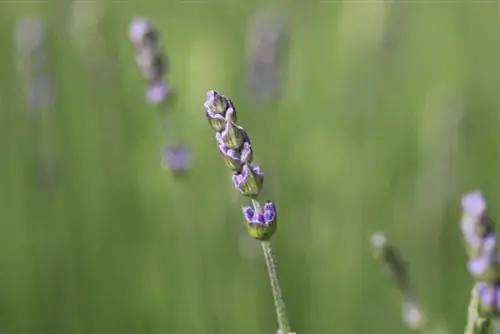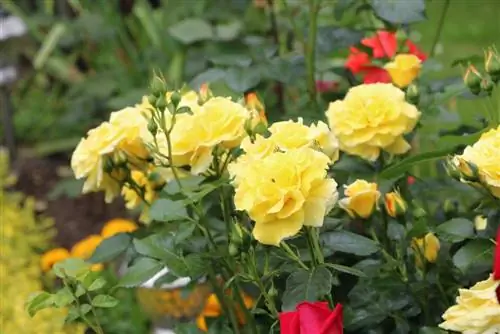- Author admin [email protected].
- Public 2023-12-17 03:39.
- Last modified 2025-01-24 12:45.
The hornbeam is one of the most popular hedge plants as a robust and easy-care tree that cannot be harmed by the city climate. It is ideal for regular topiary cutting. As a straight-cut, dense hedge it forms the green border of a property; when cut as a geometric or fantasy figure, it is the eye-catcher in every garden.
When is the best time to cut a hornbeam?
Due to its strong growth, a hornbeam hedge should best be trimmed twice a year.
February
During this time, before new growth, cut for the first time. The plants can now be trimmed vigorously. Old branches and protruding shoots must be radically removed. The hornbeam can also tolerate cuts in old wood without suffering major damage. On the contrary, the cut stimulates the plant to form as many new shoots as possible. Early pruning is recommended as birds build their nesting places in the hornbeam hedge as early as March/April.
June and August
When the hedge sprouts for the second time in May, it can be cut into shape again. From June 24th, St. John's Day, cut off all disturbing shoots. During the summer the hornbeam branches heavily and forms an opaque hedge. If you like, you can use the scissors again in August and correct the appearance of the hedge. This then stays in shape throughout the winter because new shoots no longer develop. The hornbeam hedge only loses a few leaves in autumn. These mostly dry on the tree but remain attached. This means that the hedge provides good privacy protection even in winter.
Cutting the young plant
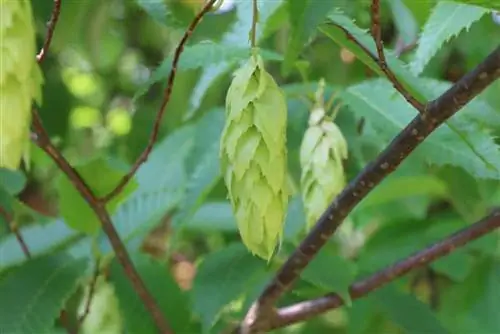
Beech hedges freshly planted in autumn are pruned immediately. A so-called training cut brings the plants into their first form. Unbranched and weak branches should be removed except for three eyes. New shoots occur here in spring. To ensure that the new hedge grows nice and thick, up to six topiary cuts can be made in the first few years.
Cutting the old plant
If the hedge plants have developed well and reached the desired height, only a few cuts are required.
In spring, before the first shoots, thinning is done radically. The best time for the second cut is in the middle of the year, when the birds' breeding season is over. You should no longer cut in the fall.
Pruning instructions
A young hedge needs to develop. This will take her a few years. For this reason, the final shape of the hedge can initially be ignored. After planting in autumn, all long side shoots are cut off and the branches growing upwards are shortened. This means the plant can sprout abundantly in spring.
Once the hedge has reached its final height, it is only pruned twice a year. In spring, the dried branches are removed and the side shoots shortened. In summer, you cut the height and width of the hedge, thus correcting the free growth according to your wishes.
Tip:
After planting, the hedge must not grow to the desired height without being cut. It would not branch sufficiently in the lower area and would remain bare. Only through regular cutting will the plant branch from trunk to tip and become beautifully dense.
Instructions for a conical cutting profile
All areas of the hedge receive sufficient light if a conical cutting profile is maintained. This means that the beech trees are cut narrower towards the top. A kind of triangle is created. This means that the areas below receive enough sun and grow densely. With a rectangular profile, the lower hedge area would be shaded too much by the upper, dense foliage and would become bare over the years.
When is a radical cut necessary?
A beech hedge that has not been trimmed for years loses its attractive appearance. The branches grow outwards and upwards uncontrollably. Since there is only a little budding, the hedge becomes bare and looks light and unsightly. In such a case, the only thing that helps is to radically cut back the trees and give them a new shape. Hornbeams can tolerate pruning right down to the old wood; they will sprout again next spring without any problems.
Tip:
Spread the radical cut over at least two years. In the first year the crown is trimmed and one side is trimmed to a conical shape, the next year the second side is trimmed. This is more tolerable for the plant and the hedge doesn't look so bare.
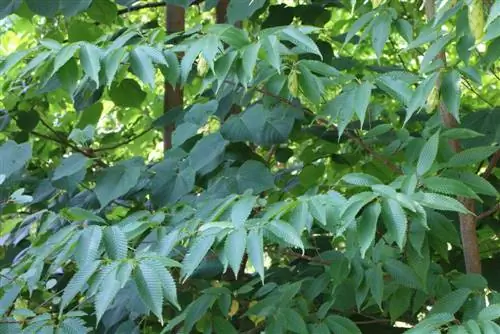
The Federal Nature Conservation Act does not allow radical cuts between March 1st and September 30th to protect breeding birds. Smaller care cuts are permitted.
When does the hedge need maintenance pruning?
Every few years the hedge needs maintenance pruning. This is usually required every two to four years for old stocks. The best time for this is August, because the trees no longer sprout as vigorously and therefore do not lose as much sap. Old branches inside are cut off under a branch. Next spring new small branches will sprout here and the hedge will become dense again.
Tip:
Don't let your hornbeam hedge grow too high. This is the only way you can carry out the cut comfortably without having to use a ladder.
Did you know that you can cut hornbeams into all sorts of shapes? With a little skill you can conjure up geometric figures such as spheres, cones, pyramids or cubes, according to your taste. A comfortable arch-shaped passage can also be cut into a very high hedge. Let your imagination run wild!
The right tool for cutting hedges
Hedges can be trimmed manually with hedge trimmers, rose trimmers and loppers or with an electric hedge trimmer. In both cases it is important that the equipment used is sharp and clean. Blunt knives tear apart the trees, branches tear open and provide a welcome breeding ground for diseases. Unclean hedge trimmers also transmit diseases.
In the case of the hornbeam with its relatively large leaves, however, it is advisable to avoid using electric scissors if possible. The rapid movement of the cutting blades shreds the delicate beech leaves and tears the small branches. Over a long period of time, the hedge will look unsightly because the interfaces dry out and turn brown. The cutting work also depends on the physical condition of the gardener. A short hedge can be cut quickly by hand, but from a certain length you should work electrically, just to save your physical strength.
Tip:
Clean your cutting devices thoroughly with water after work. If diseased branches have been removed, cleaning with spirit or pure alcohol (from the pharmacy) is necessary to avoid the transmission of diseases.
Do not dispose of diseased plant parts in the compost, the pathogens can spread further. It is better to dispose of infected clippings with household waste or burn them.
Recycle clippings
Cuttings from the hornbeam can be chopped and scattered on paths or as mulch on beds. Small branches and leaves are suitable for compost. Larger branches can be dried and burned in the fireplace.
Differences between hornbeam and columnar hornbeam
The columnar hornbeam remains narrow in its growth and resembles a pyramid. It is suitable for individual planting or as an avenue tree. Since it grows very slowly, it does not normally require any pruning. However, if it branches too much or becomes too tall, it can also be shortened considerably.
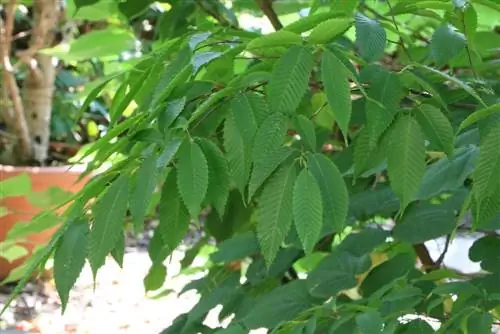
The care measure should not take place in autumn. The best time to prune a columnar hornbeam is a cloudy morning in early spring. The day must be frost-free (fresh cuttings would freeze in sub-zero temperatures) and dry; the thermometer should not show less than 5 degrees Celsius. Too much sunshine should also be avoided as the interfaces dry out quickly.
Important:
After cutting, the tree needs water.
After the care in spring, only cut the columnar hornbeam if it is absolutely necessary. Of course, dead wood should always be removed. All cutting measures will be stopped by the end of August at the latest. The hornbeam now needs rest in order to be able to sprout vigorously again the following year.
Like the hornbeam hedge, the columnar hornbeam can be cut into different shapes. A cone shape that makes the tree look like a fir makes the beech an eye-catcher in your garden.
Possible editing errors
- Never put the hedge completely on the stick, that is, cut the hedge down to the bottom. They would destroy the entire organism and the hedge would only recover after years, if at all.
- Never cut the hedge on one side, always care for both sides. This is how you get the attractive appearance of the hedge.
- Do not limit care to the outer branches. The conical hedge shape would suffer and the trees would become bare from the inside.
- Never cut back further than the third eye, as new growth would be prevented.
- Do not leave clippings on top of the hedge, as this would shade the lower areas and prevent further growth.

